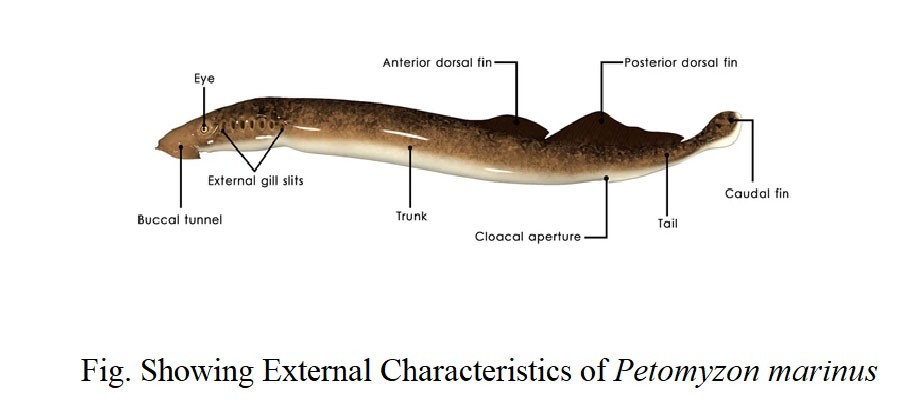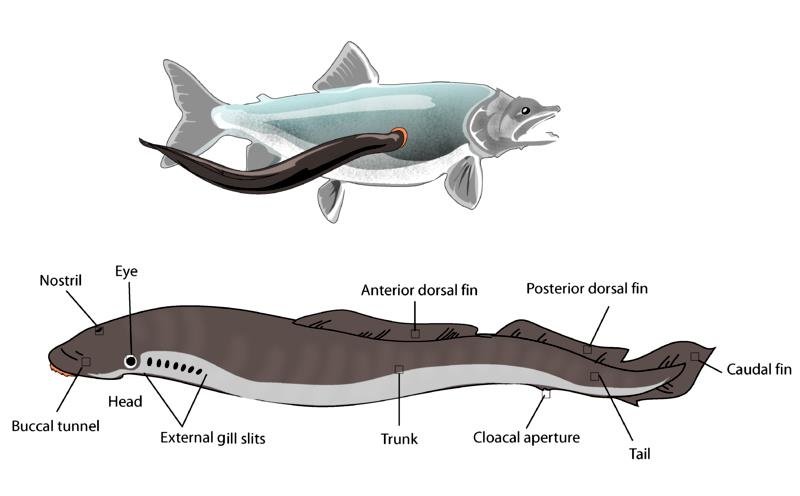Table of Contents
Body Shape of Petromyzon:
Petromyzon or Lamprey are fish-like animals in external appearance, specially Petromyzon are resemblance less or more with eels. The body is divided into three parts, the anterior cylindrical-shaped head, then the large-sized cylindrical trunk portion, and the posterior post-anal tail. The tail is laterally compressed, the head-tail and trunk are not demarketed externally.
Body Coloration of Petromyzon:
The body surface of Petromyzon is slimy due to the presence of some gland on their epidermis and the body color is greenish-brown. The body color shows different shades on the dorsal side and on the ventral side, the upper body surface is much darker and on the bottom side, the coloration of the skin is lighter.

Body Size of Petromyzon:
Body length is different in different species of Lamprey but less or more the length is around 1 Meter. For example, sea lamprey or Petromyzon marinus reach up to one meter, freshwater lamprey Lampetra fluviatilis reach around 90 cm but some species show much smaller length, Brook lamprey Lampetra planeri do not show more than 50 cm length.
Fin System of Petromyzon:
In Petromyzon the paired appendages are absent, the fins present as appendages are all unpaired. On the dorsal side of their body along the mid-dorsal line, two dorsal median fins are present one after another on the posterior end of the trunk. The two median dorsal fins are known as the first dorsal fin and the second dorsal fin. Both the first dorsal fin and second dorsal fin are supported internally by the cartilaginous rod-shaped fin rays, the fin rays are connected together at their base with the membranous sheath of the notochord. The fin rays together connected to the notochordal sheath and give mechanical support to the fin.
The tail has a caudal fin and the upper lobe connected to the second dorsal fin. Other fins remain absent in general but in Lampetra planeri females have anal fins and in males, it is reduced to a copulatory papilla.

Buccal Funnel of Petromyzon:
Petromyzon have a sucker-like structure in their mouth which helps them to attach with the body of fishes, the buccal cavity has a depression on the ventral side of their anterior end. The depression of the buccal cavity has a large number of small projections known as buccal fimbriae or papillae which makes them able to attach with the fish body.
Inside the buccal cavity, a large number of epidermal conical yellow horny teeth are present in radial arrangements. The teeth on the upper side of the mouth fuse together to form a supra oral tooth plate, the teeth on the lower side of the mouth fuse together to form an infra oral tooth plate. At the center of the buccal cavity, a circular aperture mouth opening is present, several lateral teeth are present around the mouth in concentric rows. The teeth around the mouth have two cusps so they are known as lateral bicuspid teeth. In the mouth open a tongue present and the tongue also have epidermal teeth.
Eyes of Petromyzon:
On the head the two eyes are present laterally, the eyes are not covered by eyelid, transparent portion of skin covers the eyes.

All the Aperture Found in Petromyzon:
- On anterior side, the ventral buccal cavity have only one opening for mouth which is supported by a ring of cartilage.
- On the head between the two lateral eyes a single aperture present through which the alfactory canal open outside, so there are only one single nostril in Petromyzon.
- On the head lateral side have around 7 pairs of gill slits behind the eyes.
- The slits like cloacal aperture present on ventral side of their trunk, the anus open into the cloaca, urinogenital papillae protrudes from the depression of cloacal aperture, at the tip of urinogenital papillae a urinogenital aperture present.
- Along the lateral side of the body and below head the lateral line system show its small numerous aperture on the body.
Detailed Study On
Habit and Habitat of Petromyzon(Lamprey)
Classification of Class Ostracodermi
Phylogeny of Subphylum Vertebrata
An Overview of Classification in Subphylum Vertebrata
Subphylum Vertebrata and its Diversity
Cephalochordata Characteristics Features Classification Examples and Diagram
Urochordata Classification Morphology Characteristic Features
Characteristics Features of Hemichordata
General Comparison of Hemichordata Urochordata and Cephalochordata
Comparative Study of Digestive System in Hemichordata Cephaochordata and Urochordata
Hi Everyone!!! Welcome to Imaluop. Imaluop always try to learn some new and he want to share to other people. Here we will try to learn various topics on Science, specially on Biological Sciences.